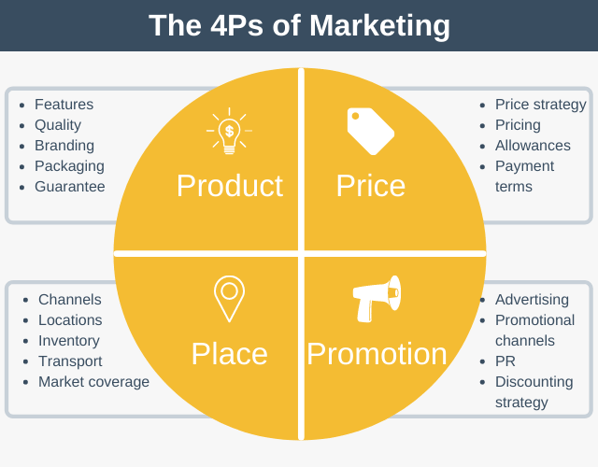Characteristics of the 4Ps of marketing
Index Content
The 4Ps of marketing are four variables that are part of a company's internal activity and that combine to create a competitive strategy in the market. These four elements are: Product, Price, Place (distribution) and Promotion.
This theory is framed in the context of the Marketing Mix, the analysis of a company's internal strategy to obtain a good position in the market. This analysis was developed and created by the American accountant Jerome McCarthy in 1960, years in which marketing acquired a multidisciplinary character.
It is a context in which the buyer's behaviour starts to be studied. The idea of an ATL marketing (Above the Line), where the market was not segmented, is abandoned and a new vision where the customer is something more than a buyer with a single need is given way to. Other variables that influence the decision making at the time of purchase are taken into account such as values, lacks, feelings, emotions... Now it is not only about attracting the customer, but also about creating "engagement" (a tie, a hook).
The first step is to define the attributes and characteristics of the product, its price, the channels that will be used to distribute it and, finally, a communication strategy for potential customers.

Characteristics of the 4Ps of marketing:
Product:
- This usually refers to an object, but a product can also be a service, a person, a place, an idea, etc. The strategy for the first P is to create a product that satisfies the buyer's needs, but not only the most immediate ones that drive them to buy
- the strategy for the first of the P's is to create a product that satisfies the buyer's needs, but not only the most immediate ones that drive them to buy. Some of the motivations that are taken into account in this sense are self-fulfilment, self-esteem or social and physiological aspects.
- To create a good product, it is necessary to think about the market, the buyer persona and the competitors during the design stage. A buyer persona is a semi-fictional representation of what the ideal buyer could be like, based on true data such as demographics, goals and objectives, financial situation...
- It is necessary that the buyer feels how much value this product has, in order to justify the purchase, and of course, that the qualities of the purchased product are always better than those of any substitute product.
- Therefore, the term does not only take into account the product itself, but also other factors such as manufacturing, packaging , etc.
- Throughout the product's life cycle, it may undergo improvements and modifications that renew and adapt it, either to new market demands or to correct specific errors.
Price:
- The price is the money charged for the purchase of a product or service. To determine it, all costs incurred during the production process are taken into account, but also during the distribution and sales process. In addition, an extra percentage must be added, which must be translated into profit.
- But the price is not only that, it is also everything that the consumer gives up in order to obtain or use the good or service he/she buys, e.g. the time he/she spends to get to the shop.
- In addition, it may be that the product or service in question has a high added value, that it is unique in the market or that it is highly differentiated from its competitors. This quality can be translated into a higher price. But there must always be a balance. This added value must always be higher than the price difference charged for it, if the customer is always paying more than the differentiation value he is getting, he will not buy the product and will give up this differentiation.
- Pricing is fundamental to gaining a competitive advantage in the marketplace. Pricing policy positions the product in the marketplace and creates a relationship with customers.
- Pricing will vary depending on whether we are creating a completely new product or a substitute for an existing one. In the case of creating a new product, two strategies can be followed: market discrimination and market penetration. The former consists of setting a high price that gives an image of quality and eliminates a large part of the market. The latter tries to do the opposite, setting a low price that will attract customers and achieve a large market share.
- Price, moreover, is a volatile and easily adjustable variable. Some of the adjustments that can be made to the price are: discounts, bonuses, promotions, as well as applying strategies such as price psychology or dynamic and geographic pricing.
Distribution:
- Made up of the processes that bring the product into contact with the consumer, from the company where it is manufactured to the consumer's hands. Fundamental figures such as suppliers and distributors intervene in these processes.
- It also refers not only to the journey that the product makes to the point of sale, but also to the point of sale itself.
- Depending on how easy it is for a company to target, it will have to use more or less channels and intermediaries. All of this will influence the selling price.
- With online commerce, distribution has changed radically. In fact, there are shops that do not offer a physical service or multi-brand businesses with corners for different brands that cannot afford to rent an entire store for their products.
Promotion:
- This is the process by which the company tries to persuasively communicate value to the customer and forge relationships with them.
- Promotion involves advertising, public relations, personal selling, sales promotion and marketing tools .
- The company's communication should always be two-way, giving the customer the possibility to initiate a conversation.
- Promotion, however, goes beyond product information, although this is an essential part of it.
- Two of the best known promotion strategies are Push and Pull. The first, translated from English as "push", consists of bringing the product closer to the consumer through distribution channels. The second, "pull", consists of attracting consumers through advertising or promotional actions.
- Nowadays, promotion is one of the variables that generates most interest in business strategy due to its great power.
However, the evolution of the market and consumer models has made this classification obsolete. Today, marketing is oriented from the perspective of the consumer, not the product. The buyer is placed at the centre of all strategies and processes, seeking to capture their attention and satisfy their needs. In the 1990s, the 4Ps of marketing were replaced by Robert Lauterborn's 4Cs.




